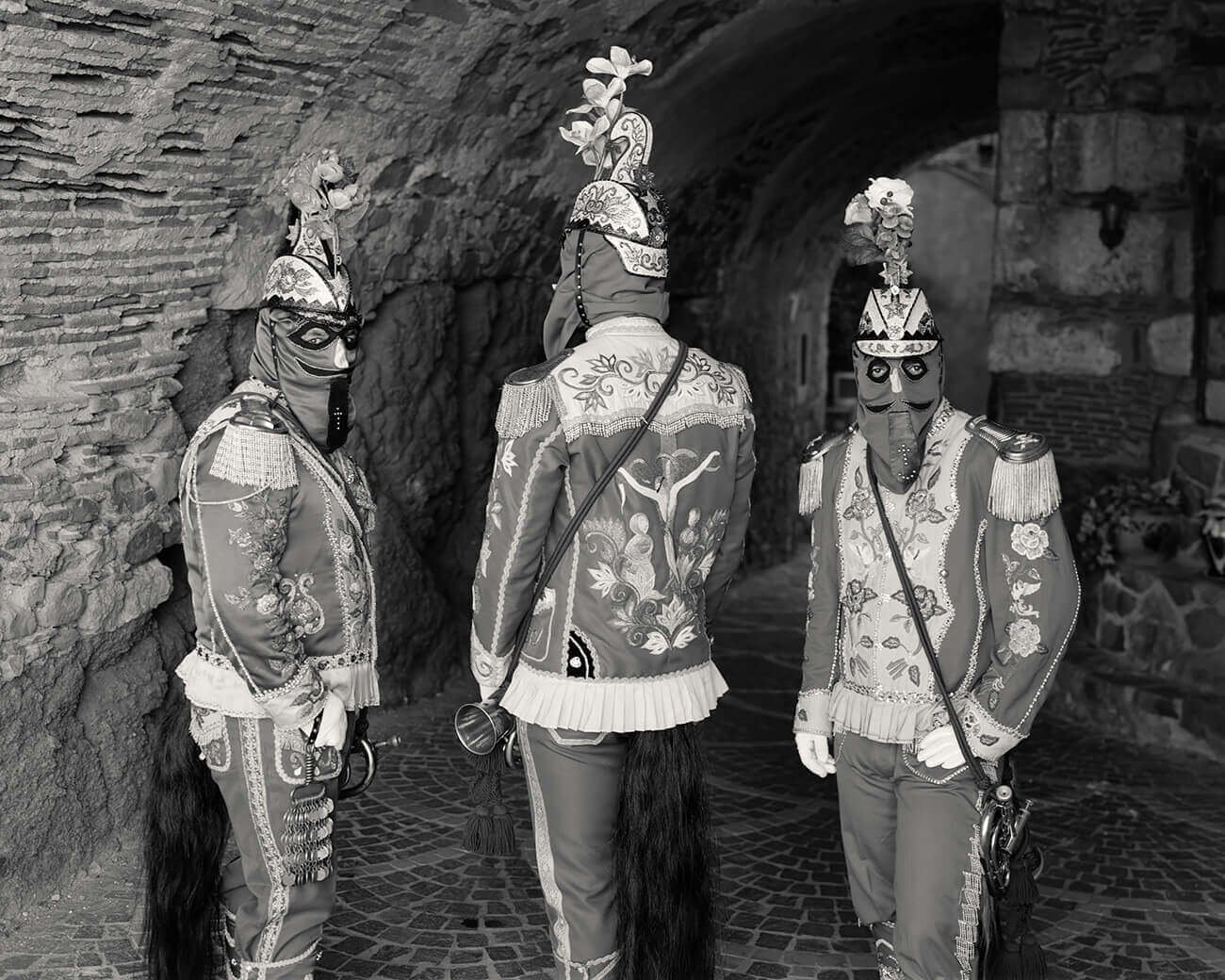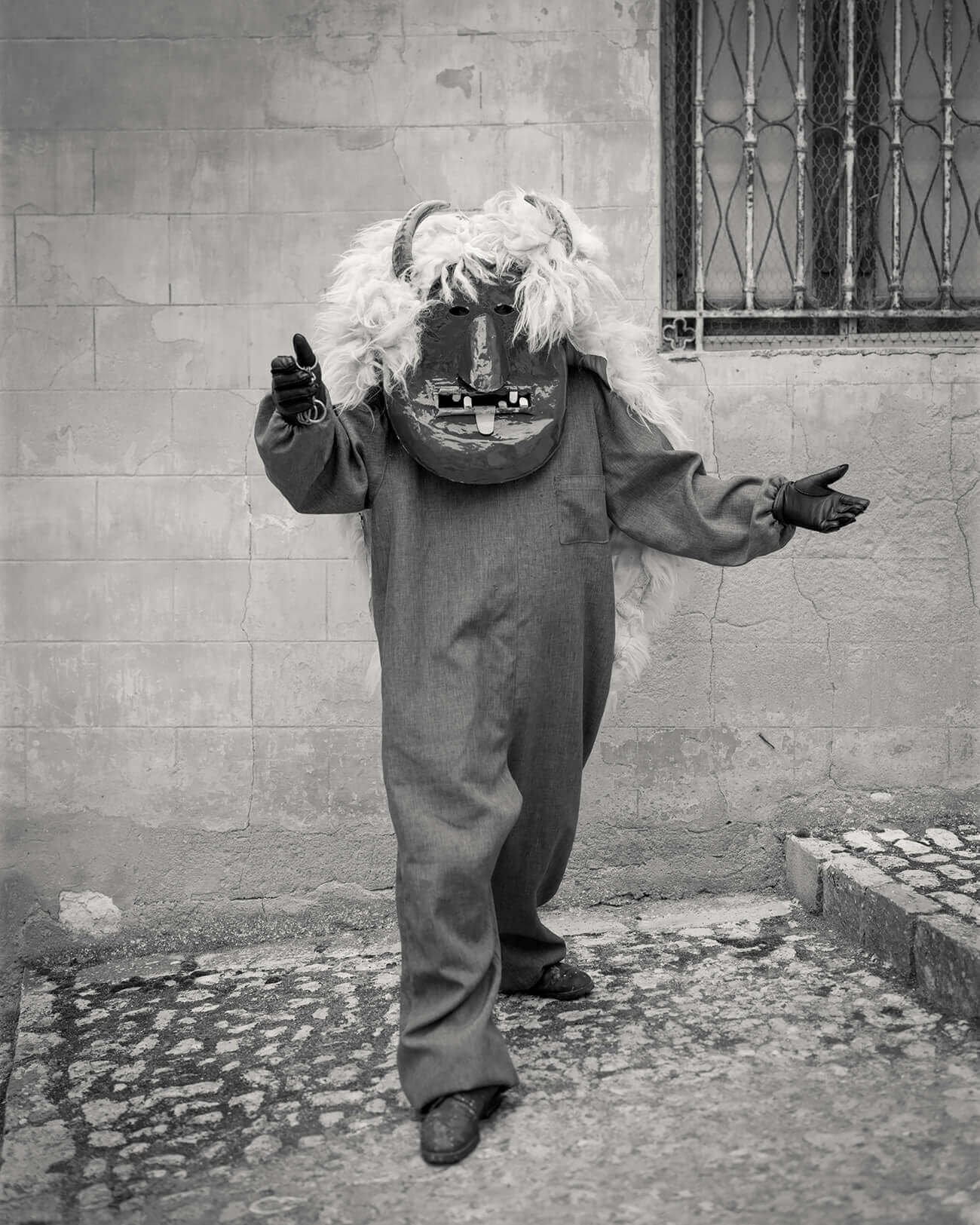Behind the Masks: Exploring Traditional Island Festivities with Alys Tomlinson
Welcome to this edition of [book spotlight]. Today, we uncover the layers of 'Gli Isolani (The Islanders),' by Alys Tomlinson (published by GOST Books). We'd love to read your comments below about these insights and ideas behind the artist's work.
"Gli Isolani" (The Islanders) by Alys Tomlinson takes us on a photo journey to discover the hidden traditions of Venice and the vibrant customs of Sicily and Sardinia. At first, Alys aimed to capture how people in Venice dealt with loss and remembered those they had lost, but it was challenging because the locals were reluctant to share these private moments with someone from outside.
Instead, Alys shifted her focus to something more visible and joyful—local festivals! The book is filled with incredible photos of people dressed in elaborate costumes and masks. These aren't just fancy outfits; they're a major part of the islanders' identity and how they celebrate their cultural heritage.
Through Alys’s lens, we see these special traditions and the deep pride these communities hold for their unique customs. Each photo tells a story about people coming together to keep their traditions alive, ensuring they thrive in our fast-paced modern world. "Gli Isolani" is more than just a collection of photographs; it's a heartfelt journey into the core of these island celebrations, revealing the importance of preserving our traditions and the joy they bring to our lives.
Inspiration and Research: What initially inspired you to explore the traditional costumes and masks of the islands in the Venetian lagoon, Sicily, and Sardinia, and how did you approach the research phase of this project?
It originally started as a project about mourning, with many visits to the cemetery island San Michele in Venice. I’d been sent there by Time Out Guides when I used to do a lot of travel photography. I remember boarding the vaporetto in the morning mist and the images of Venetian’s taking the boat to leave flowers at the graves of loved ones stayed with me. It was hard to make progress though. Venetians are quite private and they are tired of their city and people being photographed by ‘outsiders.’
I began instead looking at festivals and celebrations in Venice, although I was certain I didn’t want to document the famous Carnival. Through online research, I discovered smaller events, and this led to further research into the rest of Italy. Some of the events take place during Holy Week (pasqua) others coincide with the advent of spring or mark a particular Saint’s Day in the Christian calendar. I decided there needed to be a common thread, so I focused on islanders’ traditions – landing on the costumes and masks worn on islands in the Venetian lagoon, Sicily and Sardinia.
Cultural Significance: Could you elaborate on the cultural and historical significance of the costumes and masks featured in your photographs?
The costumes and masks are often hand-crafted by locals with meticulous care and attention. Many of them are like works of art, with incredible details and luscious fabrics and materials. Even getting dressed and ready for the photograph was a type of ritual. The celebrations and festivities are often organised by the village’s commune or association and are important annual events in the calendar.
Lots of the costumes have been passed down through generations, so become trusted emblems and heirlooms of families. Culturally, the costumes represent a range of themes – including the importance of the land and pastoral life, the changing of the seasons and fertility, redemption, religion, and death. For example, the Mamuthones of Mamoiada, Sardinia honour the older men of the village. Mamuthones dance around fires to celebrate the village saint, Sant’Antonio. Marking the end of the winter season they wear costumes made of animal fur and carry large goat bells on their backs to ward off evil spirts. During the festival the Sos Merdules (from Merdules, Sardinia) chase the animalistic Boes, said to represent the farmer’s challenges and relationship with the land. They often work in pairs, wearing anthropomorphic wooden masks, white sheepskins, black neckerchiefs and carrying tall, wooden sticks.
Photographic Technique: You've chosen to work with a large format 5x4 camera for this project. What influenced this choice, and how did it affect your interaction with the subjects and the overall aesthetic of the images?
My last three major photographic projects (Ex-Voto, Lost Summer and Gli Isolani) have all been shot on black and white 5x4 film. I was getting to a stage with my commercial photography where I was just shooting so much digitally that I needed to remind myself why I originally fell in love with photography and that was through working on analogue and spending time in the darkroom. So, I wanted to get back to that.
The large format has wonderful tonal range and detail, but for me it was more important to slow the process down. This methodical and almost meditative way of working also reflects many of the subject matters I tackle, so the act of taking a photograph becomes a ritual. Many of the images I make have a stillness and quietness which I think comes, partly, from working in this way. People also feel elevated and important when I photograph them with the large format. It’s not a snapshot or even an elaborate set-up and they can’t see results straight away, but the patience required from both the photographer and subject make it a more collaborative experience. People can see and feel the care involved in crafting an image this way.
Storytelling Through Images: How do you navigate the fine line between fiction and reality in your work, particularly in capturing images that inhabit a 'hinterland' between these two realms?
There is an otherworldliness to many of the images that I make. The photographs in Gli Isolani rely on the ‘characters’ played by the villagers once they put on the costumes and masks. The interactions, gestures and how they present themselves are often dictated by them and gently directed by me. Many of the characters I photographed for this series have a fantastical element to the way they look and dress. Sometimes, it seems they are straight out of childhood stories, dreams or even nightmares.
With my previous project about pilgrimage called Ex-Voto many pilgrims I photographed looked like they’d walked off a film set. There is of course a degree of selection in who I choose to photograph, but I am drawn to creating images that could exist in a different era and that sometimes appear to blur boundaries between fact and fiction. There is an interplay there that I enjoy exploring.
Connection to Literature: You mentioned drawing upon literature and poetry connected to the history and culture of these islands. Can you share how these literary elements informed the visual narrative of your project?
Research is a very important part of my process. I put together notebooks and sketchbooks, detailing my ideas and findings. My Italian is still basic, although many of the islanders I met communicated largely in Sardo or Sicilian, which are separate languages to Italian. The literature I read included historical novels, memoirs, poetry, and fiction, including Norman Lewis’s ‘In Sicily’, Carl Levi’s ‘Christ Stopped at Eboli’ and Colm Tóibín’s ‘The Sign of the Cross.’ Discovering Italo Calvino’s ‘Italian Folktales’ was also a turning point and some of the stories in the book relate directly to the villages and festivities that I documented.
Sometimes a single quote can have a big influence on the visual narrative. For Gli Isolani I found a quote in a memoir by Theresa Maggio that she found inscribed on an old bell in Sicily. This quote became a ‘guide’ for me throughout the project and opens the book. I kept it in my head whenever I felt I was straying from the intention of the work.
Challenges and Rewards: What were some of the challenges you faced while documenting these festivals and celebrations, and what was the most rewarding aspect of this experience?
One of the main challenges was a practical one – the outbreak of Covid-19. Originally, I was planning to visit during the actual festivities, especially over Easter, but these were all cancelled for two or three years due to the pandemic. Instead, I worked with a brilliant producer who contacted the different communities and arranged for us to photograph the locals dressed up especially for our visit. In some ways, this worked in our favour as the celebrations are often chaotic and raucous. With this arrangement, we were able to take our time and choose the backdrops and locations.
One of the most rewarding aspects has been the feedback from locals about the work. Many have said that I’ve manged to capture the essence and significance of these traditions with sensitivity and reverence. It means so much when the locals or people I’ve photographed react in that way. They are very proud of these traditions, so it is crucial that I represent them carefully and accurately.
Personal Reflections: How has working on "Gli Isolani" influenced your perspective on tradition, identity, and the role of photography in preserving cultural heritage?
I am aware that I am creating a historical document of people’s lives and with that comes responsibility. Many of these traditions are dying out as young people move from the villages to cities on the mainland, so there is a question mark over how much longer they will be in existence. Not just photography, but art in general, is key in recognising the importance of and preserving these traditions. I feel my recent MA in Anthropology has contributed to my understanding of how significant these traditions are and how embedded they are in the cultural life of the islanders. Love, birth, death, nature, faith - it’s all there in the images.
Future Projects: Having explored the traditional aspects of these island communities, are there any other cultural or geographical regions you are interested in documenting in a similar vein?
I recently finished my first film, which is a documentary feature called Mother Vera about a Belarusian Orthodox nun whom I photographed for my Ex-Voto project. The film is currently showing at film festivals and is co-directed with Cécile Embleton. I have also started a photographic project in Napoli, looking at superstition, magic, and dreams. It’s a little more experimental than my other work, so we will have to see what happens! I never set out with a full plan, but instead stay open to the possibilities around me.
To discover more about this intriguing body of work and how you can acquire your own copy, you can find and purchase the book here. (Amazon, GOST Books)
Alys Tomlinson is an acclaimed editorial and fine art documentary photographer based in London. She grew up in Brighton and pursued English Literature and Communications at the University of Leeds. Her journey in photography began in New York with her first commission for Time Out, after which she returned to London to study at Central Saint Martins College of Art and Design. Tomlinson recently completed a part-time MA in Anthropology of Travel, Tourism, and Pilgrimage at SOAS, University of London, with a focus that complements her extensive personal projects on pilgrimage. Her work has been recognized globally, including accolades such as the Sony World Photographer of the Year in 2018 and exhibitions at prestigious venues like Somerset House. Tomlinson's commitment to capturing the essence of communal traditions and personal narratives shines through in her compelling projects like "Ex-Voto," "Lost Summer," and her recent publication "Gli Isolani."
More photography books?
We'd love to read your comments below, sharing your thoughts and insights on the artist's work. Looking forward to welcoming you back for our next [book spotlight]. See you then!
















